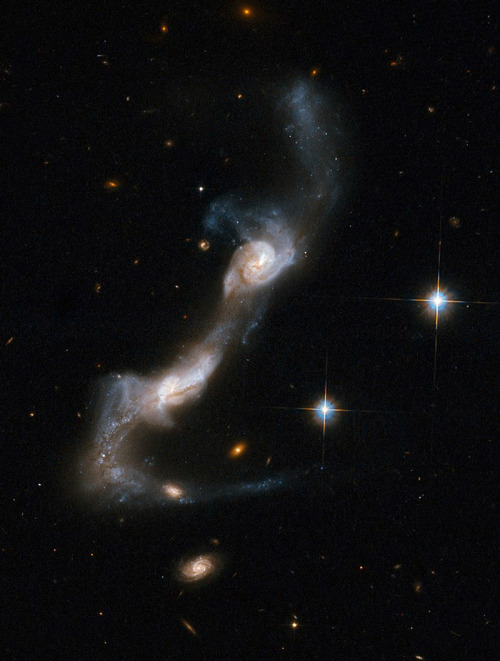The Seagull Nebula © Gianni Lacroce

The Seagull Nebula © Gianni Lacroce
More Posts from Ad-astra-affecte-spe and Others




The Milky Way arching over Lake Mungo, Australia // John Rutter

Voyager 2: Rings of Neptune (August 1989)

Corona Australis
Nebula is mostly hydrogen gas, and a small amount of metals (elements above helium) which tend to be covered as "Dust", but it's the dust that best reflect the light of the stars, and as the largest and most energetic of them are blue, you get these areas of blue haze. Hydrogen more often glows red when bombarded by UV light, the two colours together quite magical.

The area has a number of NGC objects 6726,6727,6729 but born of the same huge molecular cloud.
Our Milky Way has many such areas full of star birth, and as blue giants are not long lived, supernova and star death too.
[...] while compartmentalization and replication are important, they are aspects of what life is and does, but they do not address the why of life. The why of life is metabolism. By completing the circuit of life, biology harnesses energy from its environment. Technically speaking, this means that biology actually helps the universe cool faster; it increases the entropy of the universe. This is why the universe needs life.
Alien Oceans by Kevin Peter Hand



Cosmic Delights and Distant Discoveries Unfold in ‘Astronomy Photographer of the Year 15’

Cosmic Dance of Spiral Galaxies: Arp 238





Star Trails in Western Australia by Trevor Dobson

-
 bettiakemaai liked this · 4 months ago
bettiakemaai liked this · 4 months ago -
 glutiamentous liked this · 4 months ago
glutiamentous liked this · 4 months ago -
 silvereyedowl reblogged this · 4 months ago
silvereyedowl reblogged this · 4 months ago -
 anon-renaissance-man reblogged this · 5 months ago
anon-renaissance-man reblogged this · 5 months ago -
 anon-renaissance-man liked this · 6 months ago
anon-renaissance-man liked this · 6 months ago -
 halfmanhalfbizkit reblogged this · 6 months ago
halfmanhalfbizkit reblogged this · 6 months ago -
 lavenderro liked this · 7 months ago
lavenderro liked this · 7 months ago -
 m00nj311y liked this · 7 months ago
m00nj311y liked this · 7 months ago -
 onlyboysgay liked this · 7 months ago
onlyboysgay liked this · 7 months ago -
 slushietwink reblogged this · 7 months ago
slushietwink reblogged this · 7 months ago -
 fullautothompson liked this · 7 months ago
fullautothompson liked this · 7 months ago -
 almostkeenphilosopher liked this · 8 months ago
almostkeenphilosopher liked this · 8 months ago -
 northameicanblog liked this · 8 months ago
northameicanblog liked this · 8 months ago -
 babyjujubee liked this · 8 months ago
babyjujubee liked this · 8 months ago -
 dontmakemeturnthisuniversearound reblogged this · 8 months ago
dontmakemeturnthisuniversearound reblogged this · 8 months ago -
 dontmakemeturnthisuniversearound liked this · 8 months ago
dontmakemeturnthisuniversearound liked this · 8 months ago -
 gundam007love liked this · 8 months ago
gundam007love liked this · 8 months ago -
 simonelmago reblogged this · 8 months ago
simonelmago reblogged this · 8 months ago -
 thunderapache-blog reblogged this · 8 months ago
thunderapache-blog reblogged this · 8 months ago -
 k-llewellin-novelist reblogged this · 8 months ago
k-llewellin-novelist reblogged this · 8 months ago -
 dreebeemee reblogged this · 8 months ago
dreebeemee reblogged this · 8 months ago -
 dreebeemee liked this · 8 months ago
dreebeemee liked this · 8 months ago -
 captain72hook liked this · 9 months ago
captain72hook liked this · 9 months ago -
 hedownwithskeletor liked this · 9 months ago
hedownwithskeletor liked this · 9 months ago -
 buggzarronumber1 reblogged this · 9 months ago
buggzarronumber1 reblogged this · 9 months ago -
 randomov liked this · 9 months ago
randomov liked this · 9 months ago -
 moldyjeans liked this · 9 months ago
moldyjeans liked this · 9 months ago -
 cosmicretreat reblogged this · 9 months ago
cosmicretreat reblogged this · 9 months ago -
 cosmicretreat liked this · 9 months ago
cosmicretreat liked this · 9 months ago -
 buggzarronumber1 liked this · 9 months ago
buggzarronumber1 liked this · 9 months ago -
 stellarskyes reblogged this · 9 months ago
stellarskyes reblogged this · 9 months ago -
 paullovescomics liked this · 9 months ago
paullovescomics liked this · 9 months ago -
 topshelftussin liked this · 9 months ago
topshelftussin liked this · 9 months ago -
 sophisticatedexuberance reblogged this · 9 months ago
sophisticatedexuberance reblogged this · 9 months ago -
 sophisticatedexuberance liked this · 9 months ago
sophisticatedexuberance liked this · 9 months ago -
 lilbabysasquatch reblogged this · 9 months ago
lilbabysasquatch reblogged this · 9 months ago -
 jcapeverde reblogged this · 9 months ago
jcapeverde reblogged this · 9 months ago -
 jcapeverde liked this · 9 months ago
jcapeverde liked this · 9 months ago -
 saucerkommand reblogged this · 9 months ago
saucerkommand reblogged this · 9 months ago -
 yueryong reblogged this · 9 months ago
yueryong reblogged this · 9 months ago -
 semtituloh reblogged this · 10 months ago
semtituloh reblogged this · 10 months ago -
 semtituloh liked this · 10 months ago
semtituloh liked this · 10 months ago -
 nerdywerewolfcat liked this · 10 months ago
nerdywerewolfcat liked this · 10 months ago -
 mrlibrarian liked this · 10 months ago
mrlibrarian liked this · 10 months ago

★•Astronomy, Physics, and Aerospace•★ Original and Reblogged Content curated by a NASA Solar System Ambassador
204 posts
